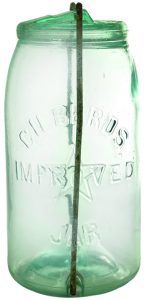ANTIQUES AND COLLECTING: Value of some bottles can be jarring
By Terry and Kim Kovel — March 20, 2022
The lid of this jar has an iron clamp closure, which added to its value because it too was identified in the glass as patented by Gilberd. It sold for $188. (Kovels)
Bottle collecting has been an important pastime since the end of the 19th century, when the first bottle seekers dug up examples in old privy pits, the town dump or a rocky seacoast area. Most sought after were historic flasks made in New England glassworks.
As flasks got more expensive, collectors searched for other bottles — bitters, inks, mineral water, pickle, snuff, whiskey, wine, food storage and canning jars, and commercial perfume bottles. The first machine-made bottles were made in 1905. By 1920, most bottles were being made by automatic machines, including modern product bottles like those for Coca-Cola and Avon. Each of these specialties attracted not only collectors but also researchers, writers and clubs.
This very light-blue canning jar with a lid is easy to identify even though it is rare. Like most, it has a name in raised glass that is formed in the mold. It says “Gilberds Improved Jar” around a five-point star. On the bottom are the words “Patd Jan 30, 1883 / Jamestown, N.Y.” It probably was made by the Findley Ohio Bottle Co. (1888-1893) for the Gilberd’s Butter Tub Co. of Jamestown, New York. It sold at a Glass Works auction for $188.
This type of jar was used over and over by a housewife making pickles or canned vegetables or fruit. Almost all food was homemade, cooked in season, and stored for the winter.
***
Q: Do you know of a school that teaches about antiques, etc.? I’ve collected and loved older items since I was 14, when I got my first computer. Since then, I’ve researched and talked to many people trying to learn about antiques. Is there a place that can help me learn where to find information about identifying real items, signatures, marks, etc.?
A: Check schools and colleges near you to see if they offer adult education courses on antiques. Go to antiques shows so you can learn to recognize important makers. Talk to the dealers. They are often very helpful. Keep asking questions. You’ll find lots of helpful information on identifying antiques, makers’ marks, factory history and prices on our website, Kovels.com. There is also a forum on our site where readers can post questions and get answers from other readers.
***
CURRENT PRICES
Belleek pitcher, cream color, honeycomb texture, iridescent yellow inside, shaped handle, elongated and scalloped spout, green mark, 4 1/2 x 3 1/2 inches, $30.
Basket, splint, oak, dyed, round, pin hinged lid, wrapped rim, bentwood handle, foot, 11 x 9 inches, $177.
Water pitcher, pewter, bulbous bottom, cinched neck, shaped handle, conical lid, disc finial, marked, William, McQuilken, Philadelphia, c. 1850, 10 inches, $375.
Quilt, applique, Princess Feather pattern, eight feathers, radiate from star center, alternating yellow and brown, gray ground, diamond stitching, c. 1900, 39 x 42 inches, $490.
***
TIP: Always keep a rug on a pad. It will wear out sooner on a bare floor.
Readers, learn the six collectibles NOT to collect anymore at www.kovels.com.
© 2022 King Features Synd., Inc.



